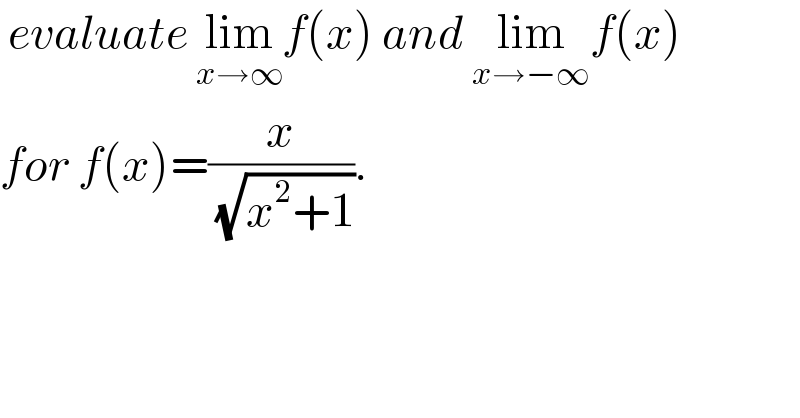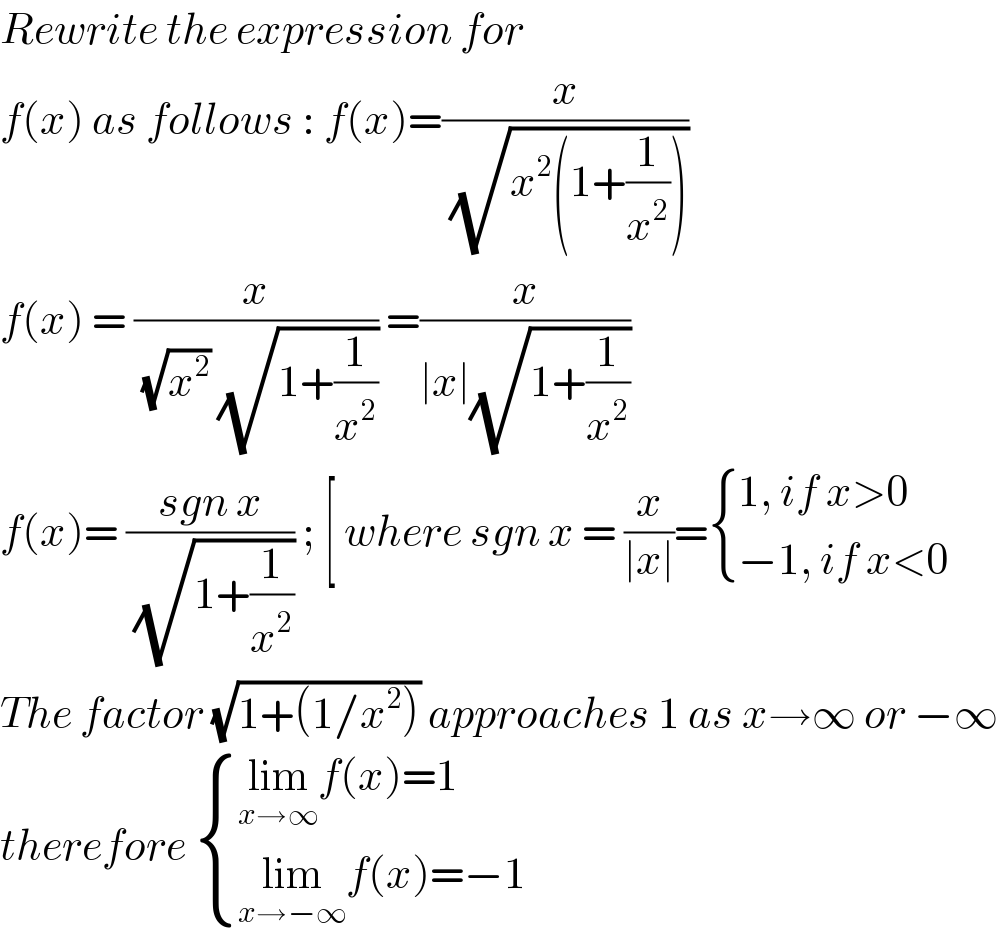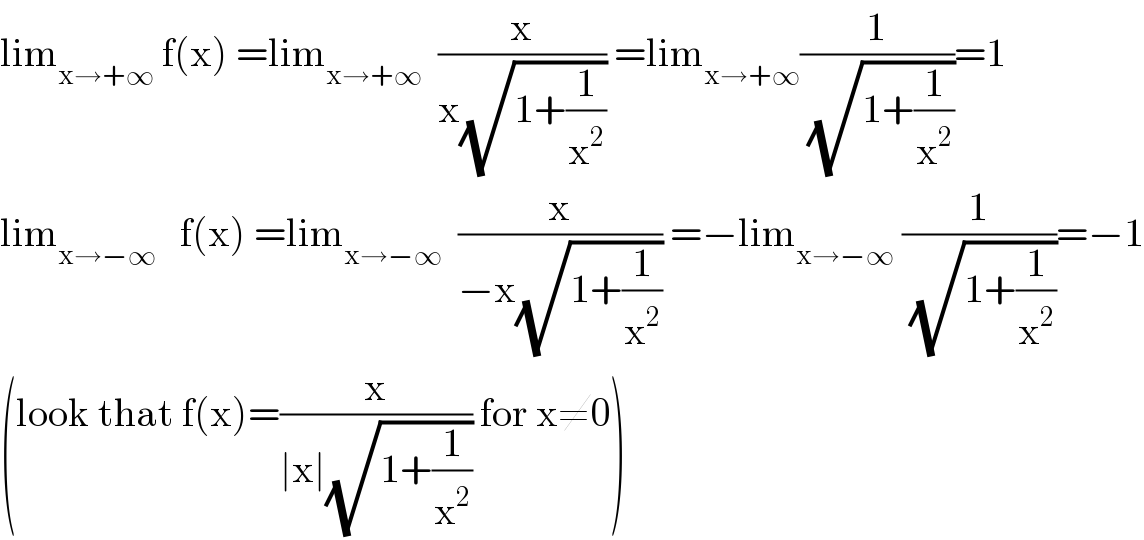
Question Number 120211 by bemath last updated on 30/Oct/20

$$\:{evaluate}\:\underset{{x}\rightarrow\infty} {\mathrm{lim}}{f}\left({x}\right)\:{and}\:\underset{{x}\rightarrow−\infty} {\mathrm{lim}}{f}\left({x}\right) \\ $$$${for}\:{f}\left({x}\right)=\frac{{x}}{\:\sqrt{{x}^{\mathrm{2}} +\mathrm{1}}}. \\ $$
Answered by Ar Brandon last updated on 30/Oct/20

$${f}\left(\mathrm{x}\right)=\frac{\mathrm{x}}{\:\mid\mathrm{x}\mid\sqrt{\mathrm{1}+\frac{\mathrm{1}}{\mathrm{x}^{\mathrm{2}} }}}=\frac{\mathrm{sgn}\left(\mathrm{x}\right)}{\:\sqrt{\mathrm{1}+\frac{\mathrm{1}}{\mathrm{x}^{\mathrm{2}} }}} \\ $$$$\underset{\mathrm{x}\rightarrow\infty} {\mathrm{lim}}{f}\left(\mathrm{x}\right)=\mathrm{1},\:\underset{\mathrm{x}\rightarrow−\infty} {\mathrm{lim}}{f}\left(\mathrm{x}\right)=−\mathrm{1} \\ $$
Commented by Dwaipayan Shikari last updated on 30/Oct/20
বাংলা শিখছো?
Commented by Ar Brandon last updated on 30/Oct/20
না, আমি কিছু মজা করছি������
Answered by benjo_mathlover last updated on 30/Oct/20

$${Rewrite}\:{the}\:{expression}\:{for} \\ $$$${f}\left({x}\right)\:{as}\:{follows}\::\:{f}\left({x}\right)=\frac{{x}}{\:\sqrt{{x}^{\mathrm{2}} \left(\mathrm{1}+\frac{\mathrm{1}}{{x}^{\mathrm{2}} }\right)}} \\ $$$${f}\left({x}\right)\:=\:\frac{{x}}{\:\sqrt{{x}^{\mathrm{2}} }\:\sqrt{\mathrm{1}+\frac{\mathrm{1}}{{x}^{\mathrm{2}} }}}\:=\frac{{x}}{\mid{x}\mid\sqrt{\mathrm{1}+\frac{\mathrm{1}}{{x}^{\mathrm{2}} }}} \\ $$$${f}\left({x}\right)=\:\frac{{sgn}\:{x}}{\:\sqrt{\mathrm{1}+\frac{\mathrm{1}}{{x}^{\mathrm{2}} }}}\:;\:\left[\:{where}\:{sgn}\:{x}\:=\:\frac{{x}}{\mid{x}\mid}=\begin{cases}{\mathrm{1},\:{if}\:{x}>\mathrm{0}}\\{−\mathrm{1},\:{if}\:{x}<\mathrm{0}}\end{cases}\right. \\ $$$${The}\:{factor}\:\sqrt{\mathrm{1}+\left(\mathrm{1}/{x}^{\mathrm{2}} \right)}\:{approaches}\:\mathrm{1}\:{as}\:{x}\rightarrow\infty\:{or}\:−\infty \\ $$$${therefore}\:\begin{cases}{\underset{{x}\rightarrow\infty} {\mathrm{lim}}{f}\left({x}\right)=\mathrm{1}}\\{\underset{{x}\rightarrow−\infty} {\mathrm{lim}}{f}\left({x}\right)=−\mathrm{1}}\end{cases} \\ $$
Answered by mathmax by abdo last updated on 30/Oct/20

$$\mathrm{lim}_{\mathrm{x}\rightarrow+\infty} \:\mathrm{f}\left(\mathrm{x}\right)\:=\mathrm{lim}_{\mathrm{x}\rightarrow+\infty} \:\:\frac{\mathrm{x}}{\mathrm{x}\sqrt{\mathrm{1}+\frac{\mathrm{1}}{\mathrm{x}^{\mathrm{2}} }}}\:=\mathrm{lim}_{\mathrm{x}\rightarrow+\infty} \frac{\mathrm{1}}{\sqrt{\mathrm{1}+\frac{\mathrm{1}}{\mathrm{x}^{\mathrm{2}} }}}=\mathrm{1} \\ $$$$\mathrm{lim}_{\mathrm{x}\rightarrow−\infty} \:\:\:\mathrm{f}\left(\mathrm{x}\right)\:=\mathrm{lim}_{\mathrm{x}\rightarrow−\infty} \:\:\frac{\mathrm{x}}{−\mathrm{x}\sqrt{\mathrm{1}+\frac{\mathrm{1}}{\mathrm{x}^{\mathrm{2}} }}}\:=−\mathrm{lim}_{\mathrm{x}\rightarrow−\infty} \:\frac{\mathrm{1}}{\sqrt{\mathrm{1}+\frac{\mathrm{1}}{\mathrm{x}^{\mathrm{2}} }}}=−\mathrm{1} \\ $$$$\left(\mathrm{look}\:\mathrm{that}\:\mathrm{f}\left(\mathrm{x}\right)=\frac{\mathrm{x}}{\mid\mathrm{x}\mid\sqrt{\mathrm{1}+\frac{\mathrm{1}}{\mathrm{x}^{\mathrm{2}} }}}\:\mathrm{for}\:\mathrm{x}\neq\mathrm{0}\right) \\ $$
